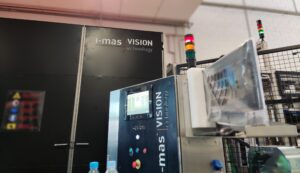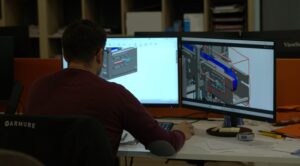At the heart of any industrial automation system, electric motors play a fundamental role. However, the true potential of these motors is achieved when they are integrated with an essential component: the variable frequency drive (VFD). This device, often invisible to the naked eye, makes it possible to control the speed and torque of motors precisely and efficiently, opening the door to more flexible, safer and more sustainable processes.
In this article, we explain what a variable frequency drive is, how it works and why it is a key part of today’s industrial environments.
What is a frequency inverter?
A variable frequency drive is an electronic device that regulates the speed of an electric motor by changing the frequency of the alternating current (Hz) it receives. Unlike a direct power supply from the mains, which delivers a fixed frequency (typically 50 or 60 Hz), a VFD can adjust that frequency according to the needs of the process.
Technically, the VFD converts alternating current (AC) to direct current (DC) and then reconverts it to AC with the desired frequency and voltage, allowing the motor to run from 0 to its rated speed or even higher, if the application requires it.
Main advantages of using variable frequency drives in process automation
1. Significant energy savings
In applications such as pumps, fans or compressors, where demand varies constantly, a VFD can reduce power consumption dramatically. Reducing the speed of a motor to 80% can result in energy savings of up to 50%, thanks to the cube law (power vs. speed ratio in centrifugal loads).
2. Increased control and precision
The drives allow smooth starting and stopping of motors, adjusting acceleration and braking ramps, and maintaining constant speed under load variations. This improves product quality and reduces mechanical wear. In addition, their integration with process automation and machine vision systems improves efficiency and traceability in complex environments.
3. Maintenance reduction
Soft start and no mechanical shock extend the life of motors, belts, gears and other components. In addition, many of today’s VFDs include preventive diagnostics and real-time data readout.
Sectors where VFD drives industrial automation
Frequency inverters are present in almost all industrial sectors:
- Food industry: control of mixers, conveyor belts or agitators.
- Water treatment: adjustment of flow rate in pumps and fans.
- Automotive: assembly lines and robotic handling.
- Textile and paper: speed management in continuous processes.
- HVAC: regulation of air or refrigerant flow to improve efficiency.
Thanks to their versatility, VFDs make it possible to adapt the performance of each machine to the actual work cycle, which is essential in the context of Industry 4.0. Their use also extends to advanced solutions in collaborative robotics and machine vision systems, where synchronization and precise control are crucial.
Digitalization and industrial sustainability
Modern variable frequency drives not only regulate motors; they are also integrated with SCADA systems, PLCs and IoT platforms. This makes it possible to monitor consumption, anticipate faults and optimize resources in real time.
In a context of energy transition and pressure to improve competitiveness, the use of VFDs is one of the most efficient and cost-effective solutions to achieve efficiency, sustainability and advanced industrial automation goals.
The frequency inverter has established itself as an essential technology in industrial automation. Its ability to adjust the speed of motors accurately and efficiently makes it a fundamental tool for improving performance, reducing energy costs and increasing the useful life of equipment.
In the engineering department of I-MAS we are committed to continuous training in this type of technology in order to offer smarter, more competitive solutions aligned with the future of the industry. Thanks to our experience in process automation, artificial vision systems and robotics, we integrate this technology as a key base in the development of customized industrial solutions.
Want to learn more about our services? Contact us or visit our projects section!



